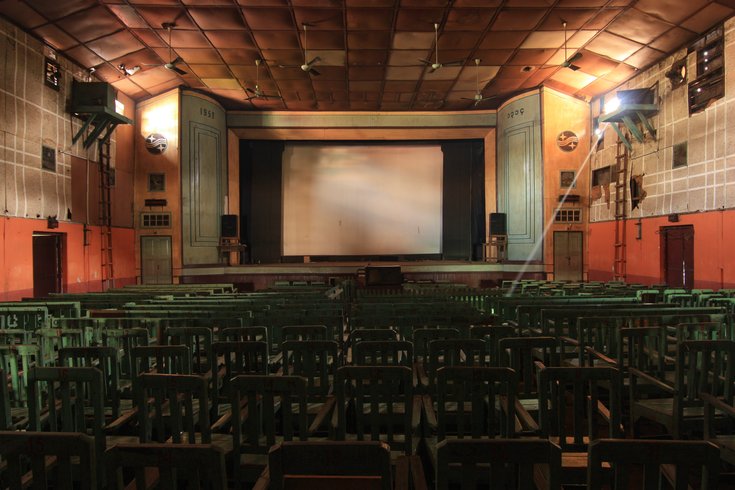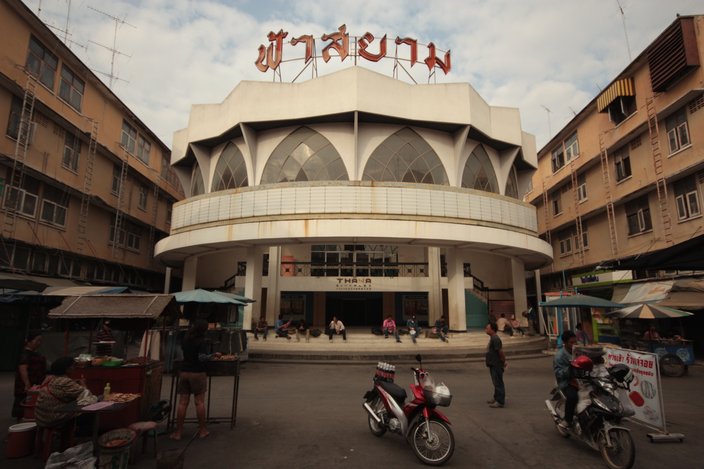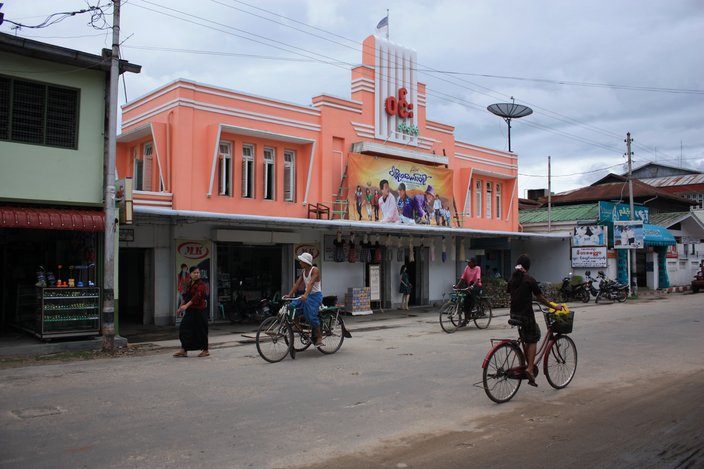
July 29, 2016
 Philip Jablon/seatheater.blogspot.com
Philip Jablon/seatheater.blogspot.com
The Mingala Thiri Cinema in Dawei, Tanintharyi Division, Myanmar.
The demolition of the Boyd Theatre last year marked the end of an era for Philadelphia, erasing the last of Center City’s bygone movie palaces from the local landscape. Philly native Philip Jablon has witnessed a similar phenomenon taking place halfway around the world in Southeast Asia. Since 2009, Jablon has made it his mission to document the region’s disappearing stand-alone movie houses with the Southeast Asia Movie Theater Project, a photo blog where he posts images and observations about these vanishing cinemas. The project began as a distraction from several frustrated attempts to write his thesis while attending grad school at Chiang Mai University in Thailand, which has since become his home for much of the year. The hobby gradually evolved into his thesis and, from there, into a full-time focus; he now shows his photographs in gallery shows while writing advocacy pieces for local and international publications. This month, PhilaMOCA will exhibit “Forgotten in Plain Sight,” a selection of Jablon’s photographs. He talked about his curious passion project while back in Philly for the summer.
You earned a degree in Asian studies at Temple and went on to graduate studies in sustainable development in Thailand. How did you initially become interested in Asian culture?
It was really from cinema. The exact instance that really sent me on that path involves one of the last movie theaters here in Philadelphia. In about 1992, when I was 12 or 13, my dad took me to the Roxy, where they screened Jackie Chan’s 'Supercop.' It was a Chinese print with English subtitles, not dubbed, and this was before Jackie Chan made it big in the West. I was blown away. I specifically remember walking back through the streets of Philadelphia toward home, still amped up from this exciting action movie, and my dad saying to me, 'You know what’s great about a movie like this, son? It shows places in the world where people like you and I will probably never go.' And I was like, 'Oh, I’m going there, Dad.' That was a really influential experience.
How did your interest pivot from the movies to the theaters that showed them?
That was a little bit later. I started grad school there in 2006 and had gone through several thesis topics. As a way to dull the pain of the idea that maybe I wouldn't finish school, I started doing this side project photographing old cinemas. It wasn’t a planned thing. As a movie lover, I’d go watch movies in my free time. There were two cinemas that I was aware of in the city, and they were both on the top floors of these rather large shopping malls, which I always thought was kind of boring, but I figured that was just the way it was over there.
Then one day while riding my bike through town, I took a turn down a small alley and came across this old stand-alone movie theater. That really opened my eyes to this whole other facet of life and culture that had gone under my radar. A few months later, I went back and it had been demolished. That was the impetus. I made a conscious decision that if this is happening here in this city, I’m sure it’s happening elsewhere in the country and I’d like to make a record.
The Fa Siam Theater in Suphanburi, Thailand.
Is there a particular architectural style for these theaters? From what I’ve seen on your site, these buildings don’t resemble American-style movie palaces.
Architecturally, they vary from country to country. The vast majority of them were built in one variation of modern architecture or another. In the U.S., most of what we think of as the grand stand-alone movie theaters were built in the late teens up through the ’30s. With the exception of the art deco ones, we were building them in one form or another of pre-modern, European revivalist styles.
Whereas in Southeast Asia, the vast majority of those that are still in existence were built from the ’50s up through the early ’80s, depending on which country you’re in, and that point in time corresponded directly with very strong movements in modern architecture. So you’ve got some brutalism, some international style, some forms of tropical art deco, and some countries have their own unique language for theater architecture.
Burma has a particular style that I’ve informally dubbed 'Burmese polychromes.' It’s just a boxy façade, but there are these beautiful multi-colored patterns all across the front. So I’m trying to get it into the mind of the Burmese, 'Hey, look, you’ve got your own unique style of movie theater, this is something you should treasure a little bit more.' I’m trying to spur the preservationist sentiment.
How endangered are these theaters?
When I first started this project, there were still probably about 30 operating stand-alone movie theaters in Thailand. Now there are a grand total of four, not including a few theaters that are operating on the sly showing porn. There are literally entire regions of Thailand where the culture that was embodied by that form is completely gone.
The Win Cinema in Taungoo, Bago Division, Myanmar.
Are the theaters and their styles reflective of the cultures or history in these countries?
If you look at when the theaters were built — in Thailand, for instance, you start to see a boom in development, including movie theaters, in 1961. That corresponds with the year that the U.S. set up military bases in Thailand because they were flying recon missions over Laos and Vietnam, who they were on the verge of getting into wars with. So the U.S. was sending military aid and economic development assistance in, and this was trickling down to society across the board.
The Motion Picture Association of America also had agents in Thailand and was bringing in films that expressed certain kinds of political messages, so it was very much part and parcel of the U.S. nation-building effort in that part of the world, trying to combat the spread of communism. At the same time, you had the development of indigenous film industries, so some theaters would specialize in Hollywood films while other theaters would specialize in Thai films or Burmese films. I’ve learned so much about how geopolitics actually works on the ground level in terms of cultural indoctrination and propaganda.
Do you feel like your work has had an impact?
Yes. I was actually just voted by Time Out Bangkok magazine as an 'expat we love.' Seven years ago, nobody cared about these buildings, and now there’s actually an active movement to revive select ones. It was really a rediscovery for a lot of people, particularly younger people.
Opening reception Wednesday, Aug. 3, 6-9 p.m.
Exhibition runs through the end of August
PhilaMOCA
531 N. 12th St.
 Philip Jablon/seatheater.blogspot.com
Philip Jablon/seatheater.blogspot.com Philip Jablon/seatheater.blogspot.com
Philip Jablon/seatheater.blogspot.com